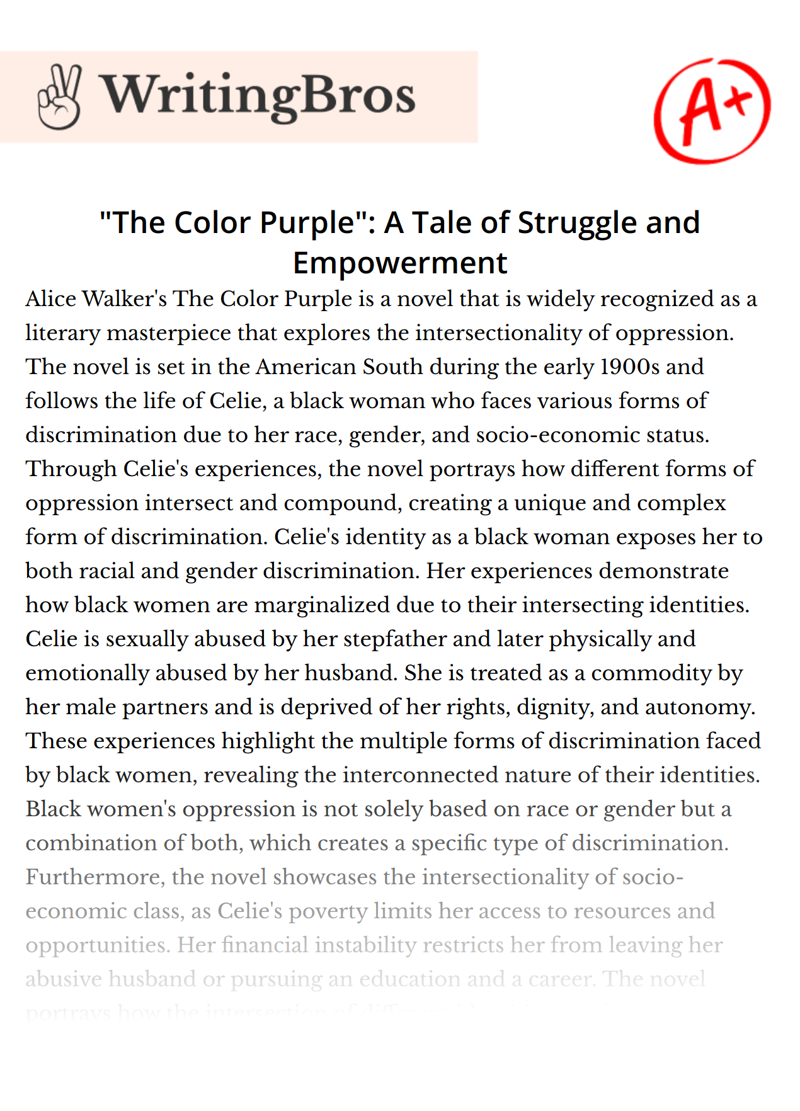"The Color Purple": A Tale of Struggle and Empowerment

Alice Walker's The Color Purple is a novel that is widely recognized as a literary masterpiece that explores the intersectionality of oppression. The novel is set in the American South during the early 1900s and follows the life of Celie, a black woman who faces various forms of discrimination due to her race, gender, and socio-economic status. Through Celie's experiences, the novel portrays how different forms of oppression intersect and compound, creating a unique and complex form of discrimination.
Celie's identity as a black woman exposes her to both racial and gender discrimination. Her experiences demonstrate how black women are marginalized due to their intersecting identities. Celie is sexually abused by her stepfather and later physically and emotionally abused by her husband. She is treated as a commodity by her male partners and is deprived of her rights, dignity, and autonomy. These experiences highlight the multiple forms of discrimination faced by black women, revealing the interconnected nature of their identities. Black women's oppression is not solely based on race or gender but a combination of both, which creates a specific type of discrimination.
Furthermore, the novel showcases the intersectionality of socio-economic class, as Celie's poverty limits her access to resources and opportunities. Her financial instability restricts her from leaving her abusive husband or pursuing an education and a career. The novel portrays how the intersection of different identities can further amplify marginalization and discrimination. Celie's experiences show how poverty compounds the oppression she faces due to her race and gender.
Despite the odds, Celie finds hope and strength in solidarity and support from other women who share her experiences of marginalization. Her friendships with Shug Avery and Sofia demonstrate the power of sisterhood and mutual aid in the face of oppression. These relationships serve as a reminder of the importance of community and support in overcoming the effects of intersectional oppression. Celie's journey is a reminder that we must support and uplift each other to combat the effects of oppression.
The Color Purple also explores the impact of religion on intersectionality. Celie's experiences with religion highlight the ways in which oppressive systems use religion to justify and reinforce discrimination. The novel portrays how religion can be used to justify and maintain power and control over marginalized communities. However, the novel also shows how religion can be used as a tool for liberation and empowerment. Shug Avery's unorthodox religious beliefs provide a sense of freedom and empowerment to Celie, highlighting the importance of religious autonomy in the face of oppression.
The novel also underscores the importance of recognizing the agency and resistance of marginalized communities. Despite the oppression and discrimination she faces, Celie's journey is one of self-discovery and empowerment. She learns to assert her voice, resist the societal norms that oppress her, and find joy and fulfillment in her life. The novel portrays the resilience and strength of marginalized communities and their ability to resist and challenge oppressive systems.
In conclusion, The Color Purple is a profound and powerful novel that portrays the intersectionality of oppression through the experiences of Celie. The novel underscores the importance of recognizing and addressing intersectionality in the fight for social justice and equality. It emphasizes the need to recognize and understand the overlapping and unique ways in which different aspects of identity and social positioning shape our experiences and vulnerabilities to systemic oppression. The Color Purple serves as an essential work of literature that encourages readers to reflect on their experiences and acknowledge the complex and interconnected nature of oppression. It is a novel that provides a profound and timely reminder of the importance of combating discrimination and oppression in all its forms.
Cite this Essay
To export a reference to this article please select a referencing style below

